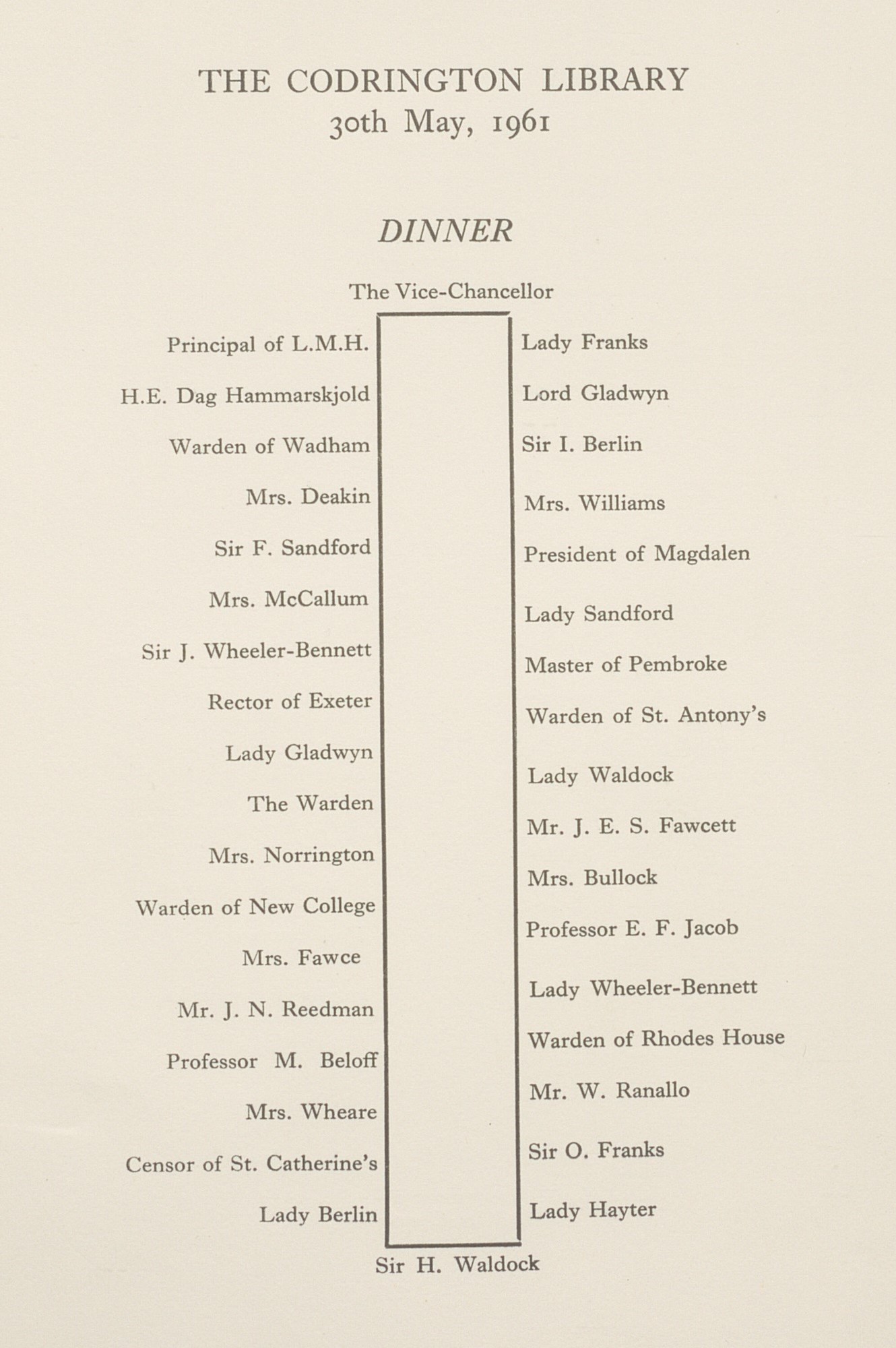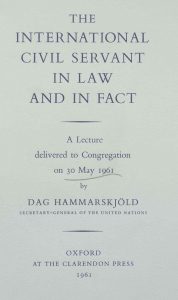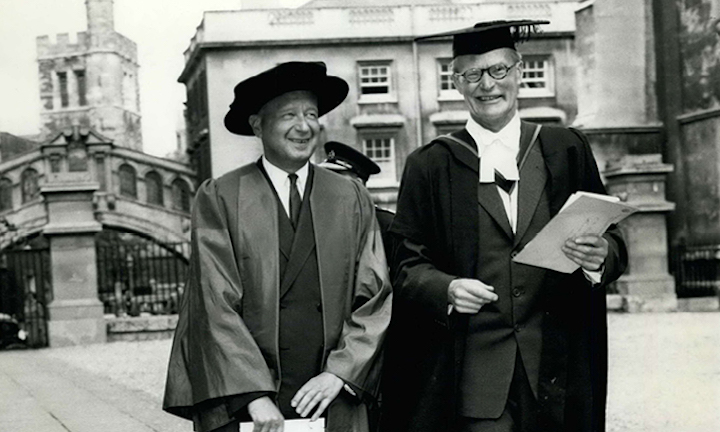Scene: The Sheldonian Theatre at the University of Oxford, Tuesday 30 May 1961. Dag Hammarskjöld, the Secretary-General of the United Nations, is the guest of honour.
Dressed in academic garb, Hammarskjöld remains seated while the Vice Chancellor recites a text in Latin conferring on him an honorary doctorate in civil law. An arcane set of gestures follows: cap dipping, presentations, more Latin.
At the end of the ceremony, Hammarskjöld delivers a lecture (in English, thankfully), entitled ‘The International Civil Servant in Law and in Fact’. While the true history of the lecture, which the Foundation has just reissued, could fill a book, in this post I’d like to focus on the untold stories behind three known versions of the text.
What we know about Hammarskjöld’s Oxford lecture
Dag Hammarskjöld’s Oxford lecture, his last major public speech, presented an ideal opportunity to respond to his detractors – of whom, at the time, there were many – and outline his thoughts on the neutrality and integrity of the international civil servant.
This was a topic that obviously had a direct bearing on his own actions as Secretary-General. But the lecture was also a deeply personal occasion for Hammarskjöld.
This is reflected in correspondence held by the Royal Library of Sweden in Stockholm. To take one example, on his return to New York on 3 June Hammarskjöld wrote to Sir Humphrey Waldock, Professor at All Souls College:
Waldock had accompanied Hammarskjöld on his 1955 mission to China to negotiate the release of 15 captive pilots, and the two continued a sporadic correspondence in the years that followed.
It was Waldock who suggested Hammarskjöld as the recipient of an honorary doctorate, invited him to deliver the lecture and even went so far as to help choose the title.
Hammarskjöld’s original suggestion, ‘International Civil Service as a Problem of Law and Facts’, lost out in the end to Waldock’s. We even have Hammarskjöld’s two sets of parallel pen marks on the original telegram to prove it.

Telegram from Sir Humphrey Waldock to Dag Hammarskjöld on 21 April 1961. Courtesy of the Dag Hammarskjöld Collection at the Royal Library of Sweden, Stockholm. Reproduced with the permission of the Hammarskjöld family.
As part of the ceremony, the university’s public orator, A. N. Bryan-Brown delivered an encomium in which he praised Hammarskjöld (again, in Latin) as ‘a servant of the whole world and a man of boundless courage’.

A signed copy of an encomium delivered by A. N. Bryan-Brown, Fellow of Worcester College and the University of Oxford’s public orator, at the convocation ceremony for Dag Hammarskjöld on 30 May 1961 at the University of Oxford. Reproduced from the Dag Hammarskjöld Collection at the Royal Library of Sweden, Stockholm, with the permission of the Hammarskjöld family.
In an article published the following day, the Times noted that Bryan-Brown ‘permitted himself a misquotation from [V]irgil: “Socium virtus coit omnis in Uno” (“The allies’ valour all unites in one”)’.
Perhaps the Times itself missed the joke: the copy of the encomium held in the Dag Hammarskjöld Collection at the Royal Library in Stockholm states “Socium virtus coit omnis in UNO”—UNO being a common acronym at the time for the United Nations Organization.
As an anonymous writer in the Daily Express observed:
Unsurprisingly, both Hammarskjöld and Waldock took a more positive view of the proceedings. Writing to the university Vice Chancellor, A. L. P. Norrington, Hammarskjöld didn’t hold back:
Meanwhile Waldock, responding to Hammarskjöld’s letter of thanks, assured him:
Brian Urquhart, in his biography of Hammarskjöld, has a different take, noting that the lecture:
But the Met Office’s weather records for Oxford in May 1961 show that the maximum temperature for the entire month was a mere 16.3 degrees Celsius. Was Urquhart there at the time? How could he have known otherwise?
Whatever the real story, if Hammarskjöld’s words did indeed achieve such an effect, it may help explain why the Times noted that he ‘was received with warmth and prolonged applause’ at the lecture’s conclusion.

The Bridge of Sighs at the University of Oxford, with the Sheldonian Theatre in the background during twilight. Photo credit: Adobe Stock.
I. The story of Hammarskjöld’s personal reading copy
So much for what we know about what happened on the day of the lecture. What about the text of the lecture itself?
At least three versions of ‘The International Civil Servant in Law and in Fact’ have circulated since its delivery on 30 May 1961. The first is, of course, the text spoken by Hammarskjöld on the day. But other than the memories of those who were in the audience – most of whom are no longer alive – no other known record exists of this performance.
Waldock explained to Hammarskjöld that university policy prohibited the presence of television cameras inside the Sheldonian Theatre. This is also the reason why there are no photographs of Hammarskjöld delivering the lecture. And while Hammarskjöld agreed to the BBC recording the event, no audio version exists in the BBC archives.
However, the Royal Library of Sweden in Stockholm holds a typed reading copy of the text. And it is this version which we must presume Hammarskjöld read aloud that ‘hot’ Tuesday afternoon in May 1961.

A scan of the first page of Dag Hammarskjöld’s reading copy of ‘The International Civil Servant in Law and in Fact’, held in the Dag Hammarskjöld Collection at the Royal Library in Stockholm, Sweden. Reproduced with the permission of the Hammarskjöld family.
The manuscript is notable for several small elements which perhaps only an editorial forensic investigator would be likely to notice.
First, a number of small handwritten corrections to the text lend weight to the argument that this was an early version created prior to its appearance in official print form (more on that in a moment).
Second, the text follows the conventions of American punctuation, including the practice of placing commas and other punctuation marks outside of quotation marks. This suggests that the copy was prepared by an American typist, perhaps Hammarskjöld’s personal secretary at the UN, or else Oscar Schachter, who worked with Hammarskjöld on the text (a fascinating story in itself).
Third, the fact that Hammarskjöld kept this typed copy of the text in his personal papers is in itself significant. Why keep this version and not any of the earlier drafts?
Curiously, Hammarskjöld also kept diagrams of the seating arrangements for the dinner held at All Souls’ College that evening. This may come as no surprise to anyone familiar with his almost fanatical obsession with table placements (an entire folder in the UN’s archives from Hammarskjöld’s time in office marked ‘Entertainment’ contains similar hand-drawn sketches).
But these two cards, together with the other ephemera he collected from the day, further suggest the symbolic significance of the trip to Oxford for Hammarskjöld, both professionally and personally. Why else would he keep these documents, and not the details of his flight to London, or his expenses, as he did with other trips?

A diagram showing the seating arrangement at a dinner in the Codrington Library at All Souls College, Oxford, for Dag Hammarskjöld on 30 May 1961. A slightly different seating arrangement obtained for dessert. Reproduced from the Dag Hammarskjöld Collection at the Royal Library of Sweden, Stockholm, with the permission of the Hammarskjöld family.
II. The story of the UN press release
Scene: United Nations Headquarters, New York City, Monday 29 May 1961 – one day before the lecture. UN Secretary-General Dag Hammarskjöld holds a press conference, his first in almost a year.
The crisis in the Congo has taken up much of the intervening time, of course, as Hammarskjöld admits:

UN Secretary-General Dag Hammarskjöld at the press conference at UN Headquarters on 29 May 1961 at which he announced that he would deliver a lecture on the international civil service in Oxford the following day. Photo credit: UN Photo.
The majority of the journalists’ questions relate to international affairs. The crisis in the Congo dominates, along with tensions between the superpowers, and nuclear disarmament.
The transcript records each of Hammarskjöld’s patient, lengthy and well-worded replies. He’s been fielding questions like these for eight years. It’s part of the job of leading this global ‘Organization’.
Right at the end, however, an unnamed reporter asks a personal question.
Although we can only speculate, it is tempting to read a sense of barely contained excitement in Hammarskjöld’s reply.
Later that day the UN Information Office issues a press release (SG/1035) containing the full text of the lecture. The heading reads: ‘For use of information media – not an official record’. The UN embargoes the text until 17:00 GMT on 30 May: the moment Hammarskjöld stands up at the Sheldonian to deliver his lecture.

A reproduction of the first page of UN Press Release SG/1035, issued on 29 May 1961, which contained the full text of The International Civil Servant in Law and in Fact. Courtesy of the Dag Hammarskjöld Collection at the Royal Library of Sweden, Stockholm.
News organisations based in New York and elsewhere spent the night of Monday 29 May poring over the text and preparing news stories based on its contents. Reprints began appearing in news media outlets from 31 May onwards.
The Scotsman, for example, published a condensed version on that day, under the title ‘Avoiding a Munich for the UN: The International Civil Servant to-day’.
The Australian Department of External Affairs published a full-text version in the June 1961 issue of Current Notes on International Affairs with the title ‘The International Civil Servant’, noting that the lecture ‘has particular topical interest in view of current attacks by Communist countries on the structure of the United Nations Secretariat and on the Secretary-General himself’.
The UN press release is the version that has become most known and read. But there is another Oxford lecture. Traces of it can be found in the version in Wilder Foote’s 1962 anthology of Hammarskjöld’s speeches (PDF), Servant of Peace, which contains three footnotes that do not appear in the press release.
How did these footnotes get there? Does it really matter?
III. The story of the OUP demy octavo version
 Oxford University Press (OUP) issued a third version of the lecture in July 1961.
Oxford University Press (OUP) issued a third version of the lecture in July 1961.
The OUP archives show that Waldock approached OUP on 31 May 1961 suggesting the text be published by the Press. The Delegates – that board of Oxford academics which regulates OUP’s publications – were happy to agree.
There was, however, some back and forth between Waldock, his secretary, OUP and the UN Information Centre in London as to the format in which the text should appear.
On 2 June Waldock’s secretary relayed a message from R. M. P. Hawkin of the UN Information Centre stating:
This is why the footnotes matter. Unfortunately, the copy of the lecture with Hammarskjöld’s original footnotes is not on file in the OUP archives.
OUP issued the lecture in July 1961 as a demy octavo-format, 28-page booklet. In its size and in the quality of the covers and inside pages, it resembles a chapbook or pamphlet more than a book.
The OUP archives show that the booklet sold at two shillings and sixpence, or 12.5 pence in today’s currency. A further note from the Secretary – or chief executive – of OUP, Colin Roberts (8 June 1961), specified that Hammarskjöld would receive 50 free copies, and that the UN could buy further copies at a 25 per cent discount (or 33.3 per cent if it ordered 1,000 copies). The title went out of print on 28 January 1966.
Apart from the 44 footnotes inserted at Hammarskjöld’s request, the UN and OUP versions also differ in style: the former follows US conventions; the latter implements the OUP house style.
The Foundation’s 2021 edition follows the OUP version. It includes the 44 footnotes, and has also been laid out in demy octavo format. But there is one small difference. In the OUP version, the footnote count restarts with each new page. We have chosen, instead, to number footnotes consecutively for the entire text.
We have also made a minor correction to a footnote in the OUP version which listed 13 July 1961 as the date for Security Council Resolution S/4387; in fact, it was 13 July 1960.

Dag Hammarskjöld (left) and A. N. Bryan-Brown, Fellow of Worcester College and the University of Oxford’s public orator, walking towards the Sheldonian Theatre on 30 May 1961. Photo credit: Keystone Pictures/TT.
Towards a definitive version of Hammarskjöld’s Oxford lecture
This post can only hope to scratch the surface of the history of what is a curious text: formal, if not stiffly legalistic in parts; at other times, freewheeling and intellectually commanding. It is as if behind each sentence there lurks yet another story, a personal association or a barely disguised feud.
Many of the sources listed in Hammarskjöld’s footnotes remain difficult to access. But several digitisation efforts are underway. For example, the lecture refers to several League of Nations texts, which the UN Library at Geneva’s LONTAD project aims to digitise and catalogue. A full scholarly edition of the lecture may one day include updated references to these and other texts.
Apart from the text of the lecture, though, there are several other aspects of Hammarskjöld’s trip – including his meetings with British Government officials, and his rather more interesting encounter with the sculptor and artist Barbara Hepworth – that will have to wait for a future post.
In the meantime, I hope the Foundation’s new edition makes clearer the sources behind Hammarskjöld’s remarks, and rekindles interest in the issues he discusses in the lecture.

 Jemina Holmberg
Jemina Holmberg